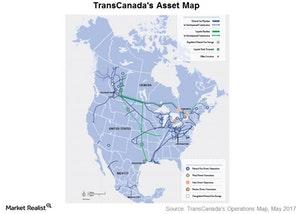TransCanada: An Overview of Assets and Operations
TransCanada (TRP) was founded more than 65 years ago, and its operations spread across seven Canadian provinces, 38 US states, and Mexico.
July 14 2017, Published 2:29 p.m. ET

Business overview
TransCanada (TRP) was founded more than 65 years ago, and its operations spread across seven Canadian provinces, 38 US states, and Mexico. TransCanada operates natural gas and liquids pipelines, gas storage facilities, and generates power. It operates one of the largest natural gas transmission networks that extend more than 56,900 miles running across all major gas supply basins in North America. TransCanada’s natural gas pipelines network supplies more than 25% of the natural gas consumed in North America.
The above map shows the geographical spread of TransCanada’s assets.
TransCanada operates three core businesses—natural gas pipelines, liquids pipelines, and energy. After the acquisition of Columbia Pipeline Group in 2016 TransCanada reports operations in five segments—Canadian Natural Gas Pipelines, U.S. Natural Gas Pipelines, Mexico Natural Gas Pipelines, Liquids Pipelines, and Energy.
Gas storage, liquids pipeline, and energy
TransCanada is also North America’s largest provider of natural gas storage, with 653 billion cubic feet of storage capacity.
TransCanada’s Keystone Pipeline System transports 545,000 barrels of crude oil per day, which constitutes ~20% of Western Canadian exports to refinery markets in the US Midwest and Gulf Coast.
TransCanada owns 17 power generation facilities with a capacity of 10,700 megawatts. Nearly one-third of the power TRP provides is generated from emission-less or renewable sources, including nuclear, hydro, wind, and solar.
In this series
In this series, we’ll learn about TransCanada’s business and operations, its segments, its capital projects, analyst recommendations, and an outlook for the stock.
Let’s start with a focus on TransCanada’s five segments.
